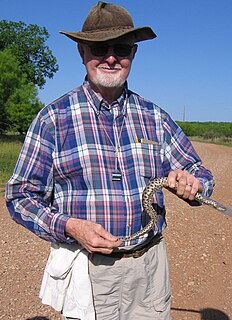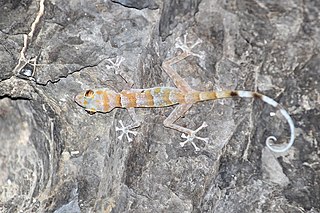
The Rodrigues giant day gecko is an extinct species of day gecko. It lived on the island of Rodrigues and surrounding islands and typically dwelt on trees. The Rodrigues giant day gecko fed on insects and nectar, and, unlike most other day geckos, was apparently nocturnal in habit.

Asaccus is a genus of geckos, commonly known as Southwest Asian leaf-toed geckos, in the family Phyllodactylidae.

Tarentola mauritanica, known as the common wall gecko, is a species of gecko (Gekkota) native to the western Mediterranean area of North Africa and Europe. It has been introduced to Madeira and Balearic Islands, and the Americas. A nocturnal animal with a predominantly insectivorous diet, it is commonly observed on walls in urban environments in warm coastal areas; it can be found further inland, especially in Spain where it has a tradition of cohabitation with humans as an insect hunter. A robust species, up to 15 centimetres (5.9 in) long, its tubercules are enlarged and give the species a spiny armoured appearance.

James Ray Dixon was professor emeritus and curator emeritus of amphibians and reptiles at the Texas Cooperative Wildlife Collection at Texas A&M University. He lived in El Campo, Texas throughout most of his childhood. He published prolifically on the subject of herpetology in his distinguished career, authoring and co-authoring several books, book chapters, and numerous peer reviewed notes and articles, describing two new genera, and many new species, earning him a reputation as one of the most prominent herpetologists of his generation. His main research focus was morphology based systematics of amphibians and reptiles worldwide with emphasis on Texas, US, Mexico, Central America, and South America, although bibliographies, conservation, ecology, life history and zoogeography have all been the subjects of his extensive publications.
Leaf-toed gecko is a common name for some species and genera of gecko and refers to a divided, expanded adhesive pad at the distal end of the toe, resembling a ginkgo leaf. Members of the following genera are commonly called "leaf-toed" geckos:
The Kurdistan leaf-toed gecko is a species of lizard belonging to the gecko family Phyllodactylidae. A. kurdistanensis is native to the Kurdistan province in western Iran and was described in 2006.

Kotschy's gecko is a species of gecko, a lizard in the family Gekkonidae. The species is native to southeastern Europe and the Middle East. It is named in honour of the Austrian botanist and explorer Karl Georg Theodor Kotschy.

Asaccus elisae, also known as Elisa's leaf-toed gecko or Werner's leaf-toed gecko, is a species of gecko, a lizard in the family Phyllodactylidae. It is found in the Middle East, from southern Turkey through eastern Syria and northern and eastern Iraq to western Iran.
The mountain leaf-toed gecko is a species of gecko. It is endemic to Yemen. It is sometimes considered conspecific with Hemidactylus yerburyi.
Asaccus andersoni is a species of leaf-toed gecko endemic to Iran, on the western slopes of the central Zagros Mountains. It lives in on rocks in gullies of mountainous oak forests. It is named in honor of Steven Clement Anderson, in recognition of "his major contributions to the knowledge of the herpetofauna of the Middle East and the Iranian Plateau in particular".
The Kermanshah leaf-toed gecko is a species of gecko endemic to Iran. It is named for the type locality, north of Kermanshah, eastern Kermanshah Province, in the Zagros Mountains of western Iran. It is found in caves and rock crevices at 1,400 m (4,600 ft).

Asaccus nasrullahi, Nasrullah's leaf-toed gecko, is a species of gecko in the family Phyllodactylidae. The species is endemic to Iran. The specific name nasrullahi was chosen in honor of Iranian herpetologist Nasrullah Rastegar-Pouyani, "in recognition of his contribution to the knowledge of the herpetology of Iran, including the genus Asaccus".
Asaccus tangestanensis is a species of leaf-toed gecko endemic to Iran. This gecko is found in the southern Zagros Mountains in Bushehr Province. It is found in cliffs and caves. The holotype was collected in 2008 and the species is named for Tangestan, the type locality.
Asaccus zagrosicus is a species of leaf-toed gecko endemic to Iran. The holotype was collected in 2008 in southern Lorestan in the Tang-e-Haft Region between the central Zagros Mountains and Khuzestan Plain.
The Emirati leaf-toed gecko is a species of lizard in the family Phyllodactylidae. It is endemic to the United Arab Emirates.
Asaccus gallagheri, also known as Gallagher's gecko or Gallagher's leaf-toed gecko, is a species of lizard in the family Phyllodactylidae. It is endemic to the Arabian Peninsula and occurs in the United Arab Emirates and Oman.
Asaccus montanus, also known as the mountain leaf-toed gecko is a species of lizard in the family Phyllodactylidae. It is endemic to Oman.

Asaccus platyrhynchus, the flat-snouted leaf-toed gecko, is a species of lizard in the family Phyllodactylidae. It is endemic to northern Oman, in desert and rocky areas. Asaccus platyrhynchus was first formally described in 1994.
Edwin Nicholas "Nick" Arnold, is a British herpetologist and former Curator of Herpetology at the Natural History Museum, London. Arnold made seminal contributions to the herpetology of Europe and North Africa, especially on geckos and lizards of the family Lacertidae. He discovered and described 36 species and 4 subspecies of reptiles, and wrote A Field Guide to the Reptiles and Amphibians of Britain and Europe, which appeared over multiple editions.

The Al Hajar montane woodlands is a temperate grasslands, savannas, and shrublands ecoregion in the Al Hajar Mountains on the eastern Arabian Peninsula, which extends across portions of Oman and the United Arab Emirates.








